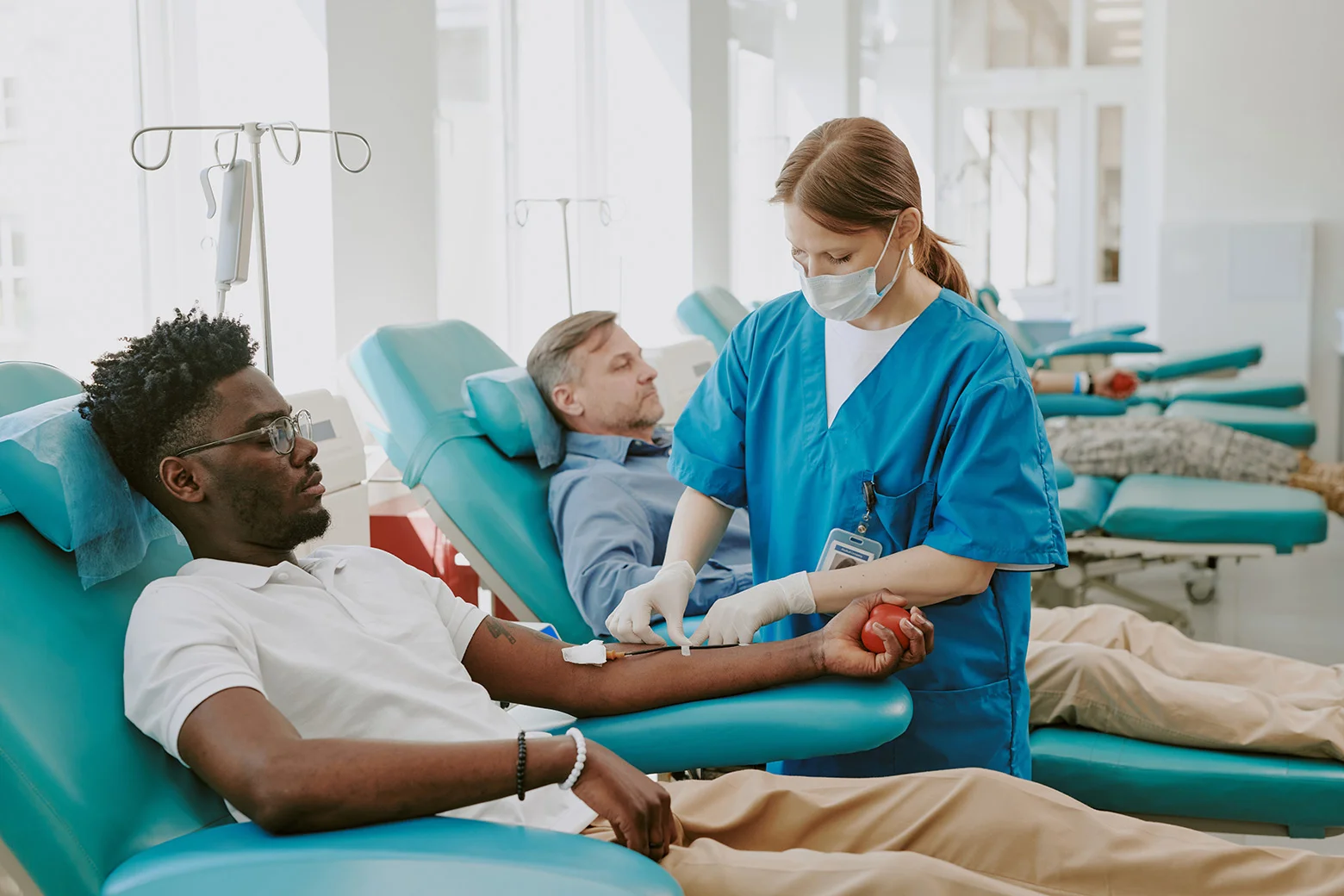Copyright Slate

Sign up for the Slatest to get the most insightful analysis, criticism, and advice out there, delivered to your inbox daily. Shortly before Thanksgiving in 2023, Amber Kirkpatrick, a mother of three, nearly bled out in her driveway. A few months into her third pregnancy, Kirkpatrick had started taking a blood thinner to treat a clot in her lung. Her delivery went well. But two weeks postpartum, driving home from her mother’s house, she began to bleed. She pulled into a gas station, suddenly hemorrhaging. “I got out, and it was completely covering everything in the parking lot, all in the car,” she remembers. Despite the bleeding, she continued home and made it as far as her driveway before she couldn’t get any farther. She sat in the garage, dizzy and almost unconscious. Blood was everywhere. Her husband called 911. Sitting there, hemorrhaging on the garage floor, she ate some leftover rotisserie chicken and managed to stay awake until a team of paramedics arrived. About a year earlier, the EMS service in Kirkpatrick’s North Carolina county had begun a blood-transfusion program, administering blood to the most critical patients before they arrived at a hospital. Seeing how briskly Kirkpatrick was bleeding, the medics began transfusing her right in the driveway. She faded in and out of consciousness during the ride to the hospital but remembers the paramedics talking to her about their own families, telling her that she was going to be fine. Around 20 minutes later, Kirkpatrick arrived at Mission Hospital in Asheville, still bleeding. “I was losing blood as fast as they could give it to me,” she recalls. Her doctors infused red blood cells, as well as platelets and plasma. Finally stabilized, she underwent emergency surgery that evening and ultimately returned home to her healthy newborn son. A year after Kirkpatrick’s bleed, Hurricane Helene hobbled the supply chain of the Blood Connection, the community blood center serving much of the region. Donation centers lost power, and bloodmobiles couldn’t travel on dangerous roads. The American Red Cross reported that due to the cancellation of blood drives, more than 2,500 blood donations went uncollected in western North Carolina. For Kirkpatrick, the system had worked—an extraordinary connect-the-dots from the arms of dozens of donors to her driveway to an ambulance to, finally, the operating room. But had her hemorrhage happened on the day of the hurricane, she may have bled to death. As an emergency physician, I order blood routinely. I care for cancer patients with low blood counts following chemo, elderly patients with GI bleeds, young people with gunshot and stab wounds. Sometimes, the blood is important but not necessarily lifesaving. Other times, I’ve watched patients vomit blood faster than the rapid infuser can pump it in. In either case, I’m unlikely to stop and think about where all that blood came from or what I would do if it ran out. But most hospitals—even big trauma centers—generally don’t have as much blood on hand as they’d like, often competing for access to enough blood to keep things running. The patchwork system that supplies blood and blood products to operating rooms, delivery suites, and ERs like mine can be frighteningly brittle. Like an overwhelmed air traffic control system deflecting near misses, the U.S. blood-supply system often gets the job done with a surprisingly slim margin of error. On any given day, the system is strained at best and startlingly close to crisis at worst. To prepare for the emergency around the corner, blood banks and hospitals need to consider big changes. There are some promising solutions, such as developing walking blood banks, which adopt the military strategy of identifying donors ready to give at a moment’s notice. And though paying donors for blood is unlikely due to safety and ethical concerns, at least one startup offers incentives in the form of free blood testing in exchange for donations. The solution will likely be many-veined, but what’s certain is that something has to give. As one director of a hospital blood bank told me, “I personally think the volunteer blood supply is going to collapse in our lifetime.” The culture of blood donation in the U.S. evolved during World War II, shortly after several discoveries that advanced transfusion medicine and at a cultural moment when extraordinary home-front efforts supported Allied troops. In our current polarized political landscape, the requisite altruism may ring hollow to potential donors, especially younger ones: According to the industry group America’s Blood Centers, donations from individuals 19 to 24 years old decreased by 32 percent from 2019–21, while donations from individuals over 65 increased by 41 percent in the same period. According to a survey by Blood Centers of America, a network of more than 60 community blood centers, the average donor age increased from 44 in 2013 to 51 in 2023. Even more telling, though 62 percent of the U.S. population is eligible to donate blood, only 3 percent actually does. There is some good news. After years of decline and a COVID-related dip, the amount of blood collected in the U.S. has leveled off. The National Blood Collection and Utilization Survey, which tracks the country’s blood supply, indicates that in 2023, roughly 11 million units of blood were collected, while 10.3 million were used. The surplus here provides only modest insurance in the case of a sudden increase in demand or dip in supply—and an average national surplus is cold comfort for a rural hospital facing a mass shooting or a hemorrhaging mother exhausting the local hospital’s blood bank. As the number of prehospital transfusions like Kirkpatrick’s increases, along with startingly frequent traumatic mass-casualty incidents, we may soon find that the demand for blood will rise once again. Will we be ready to meet it? For all the patients I’ve seen with massive hemorrhage in the ER trauma bay, I’ve seen more who have bled to death before reaching the front door of the hospital. If you imagine the need for blood extending to the crucial time before patients arrive, then the demand increases considerably. I asked Andre Cap, a retired Army colonel and hematologist who formerly led the Army Blood Research Program, to help me understand the potential of prehospital transfusions. “We are not delivering the blood to the people who need it the most, who are dying at our doorsteps,” he told me. “And so when we say blood supply and demand are matched or in equilibrium, you’re ignoring this massive demand that we’re just pretending isn’t there. That’s a colossal problem.” One study estimates that, depending on the acuity of their conditions, somewhere between 54,000 and 900,000 patients would be candidates for prehospital blood transfusions in the U.S. annually. The proportion of EMS agencies that offer these programs remains tiny, but the number has increased dramatically in the past several years. The first program in the U.S. launched in 2016, and two years later there were fewer than 10 nationwide. Today the number approaches 300. If the trend continues, the need for whole blood (blood that hasn’t been separated into components like red cells and plasma) for prehospital use could rise dramatically to meet demand. Even though launching these new blood programs is a heavy lift for the system, there’s a significant payoff. Military and civilian studies alike show that offering blood as soon as possible saves lives. One recent review of EMS data suggests that if prehospital blood were universally available, more than 20,000 lives would have been saved over the four-year study period. That’s remarkable, and to make it happen would take thousands of blood donors that we don’t seem to have. John Hagins, the CEO of a Midwestern community blood center, chairs the cooperative blood center task force of the Association for the Advancement of Blood and Biotherapies, America’s key blood center and transfusion medicine organization. Raw material, Hagins told me, is nearly always in short supply. Nationwide, the amount of type O blood is typically measured in days, with rarely more than a five- or six-day inventory on hand. If donations dip due to weather or COVID or a flu outbreak, the system might not be able to accommodate additional demands for blood. “We manage a scarce resourse,” Hagins explained. “We still have not found the right way to have a national dialogue about the importance of donating blood.” Recruiting volunteers remains a challenge, despite disturbingly frequent “emergency blood drives” and incentives like gift cards. In 2020 a report from the Department of Health and Human Services encouraged new thinking when it came to donor recruitment. “We need a national call to action and engagement,” its authors implored. But since then, despite widespread agreement that recruitment strategies must be reenergized, few concrete plans have emerged. A cooperative industry task force keeps tabs on the state of the national blood supply, sharing weekly estimates with partner centers as well as HHS. The task force also coordinates blood shipments during emergencies. In the early days of COVID, the group shipped hundreds of units of blood to the Pacific Northwest, where donations essentially stopped. In 2021 an additional consortium called the Blood Emergency Readiness Corps formed to ensure that on-call units of blood could be shipped to areas of need within hours, but more radical transformation has yet to occur. During mass-casualty events, hospitals are challenged to provide blood for potentially dozens of patients simultaneously. In the immediate aftermath of the 2017 Las Vegas shooting, for instance, victims collectively received 278 units of blood. That’s more than many hospitals have on hand. After the 2023 shooting in Lewiston, Maine, the Red Cross provided 175 units of blood to local hospitals, prompting an urgent call for donors to help resupply the community. A 2022 analysis of blood centers in major U.S. cities concluded that following a small vehicle-bomb explosion in a crowded venue like a sports arena, most of the cities studied would not have enough plasma or platelets to treat victims, and many would be at risk of not having adequate red blood cells. “A lack of available blood products,” a group of trauma experts wrote in the journal Transfusion in 2020, “likely contributes to preventable deaths during” mass-casualty incidents. Among those experts was Donald Jenkins, a former Air Force surgeon who has championed the idea of whole-blood transfusion in the field, and whose South Texas program was one of the first in the nation. Now a professor of surgery at the University of Texas, Jenkins recently told me that especially following strings of mass shootings, “you realize how we’re on a razor’s edge every day with platelets and sometimes with red cells.” (Platelets are another blood product given to bleeding patients, and they’re often a limiting factor in how successfully someone can be resuscitated.) But a long list of barriers has prevented widespread adoption of prehospital whole-blood programs: cost, regulatory requirements, cold-chain access, reimbursement policies, and, perhaps most importantly, an adequate number of donors. Taking a page from battlefield medicine, Jenkins and some other transfusion experts have proposed “walking blood banks,” in which preidentified donors can be called upon during an emergency to donate whole blood. In a more radical version of the proposal, there’s no need for storage—only a willing group of prescreened volunteers who respond and donate at the time of need. The blood goes from a donor into a collection bag, then into a recipient. Though it’s already in use in the military, a civilian walking blood-bank strategy faces regulatory hurdles and ethical challenges. The biggest catch is that federal law prohibits blood suppliers from releasing blood that hasn’t been tested for infections like HIV and hepatitis C (although it’s unclear if the same regulation applies to hospitals and EMS agencies). Some proponents have argued that prescreening is enough—that blood obtained from a walking blood bank during an emergency shouldn’t have to be screened at the time of donation if a donor recently tested negative. Critics, however, argue that transfusing blood directly from donor to recipient without totally reliable testing for infection isn’t worth the risk, even if those donors are regularly screened at predetermined intervals. Faced with the choice between receiving a lifesaving transfusion from a volunteer donor who tested negative for HIV and hepatitis C two months ago or else bleeding to death, I’ll take the blood. Unfortunately, few studies have tested public opinion on tough choices like this. Point-of-care testing, which represents a compromise between lab testing and none at all, can be done quickly and pretty much anywhere but doesn’t have the accuracy of formal lab results. For now, the proposal hovers in a state of regulatory and financial ambiguity. If implemented, whole blood from walking blood banks can be available immediately wherever it’s needed: Think “blood deserts” like a remote Alaskan village, a ship at sea, the site of a rural school shooting. What better place to store an emergency blood supply than circulating in the bodies of nearby volunteers? Some version of a civilian walking blood bank may soon become a reality. If it does, it will be a small but valuable contribution to a larger puzzle of balancing blood supply and demand, managing ebb and flow in donation, and mitigating the impact of unexpected events. As rapid testing improves in availability and accuracy, accommodations could be made to turn blood around both quickly and safely. Yet for now, the system remains fragile at best, without any obvious paradigm shift on the horizon. We manage a tenuous balance of supply and demand. For her part, Amber Kirkpatrick, who received transfusions on the floor of her garage, plans to sponsor a blood drive at a community event. She’s waiting until she gets her doctor’s clearance, though: She wants to donate too.


